How to choose Indiana Line speakers depends of the room size?
The selection of loudspeakers to the size of a listening room has a substantial impact on the quality of the sound that we will ultimately achieve with their use. It might seem that the issue is simple – small bookshelf speakers are suitable for small rooms, and floorstanding speakers for larger ones. However, it is not entirely so obvious, because additional factors should also be taken into account, such as the shape of the room. The interior acoustics must not be overlooked when choosing the columns. It is no less important than the matching of individual elements that create a stereo set (with floorstanding/bookshelf speakers) or a home theater (equipped with a central speaker, ceiling/effect speakers).
Contents: How to choose Indiana Line speakers depends of the room size?
- Which loudspeakers for the living room or other room?
- Loudspeakers and the size of the room
- Subwoofer as an additional woofer
- Capacity, shape and acoustics of the room
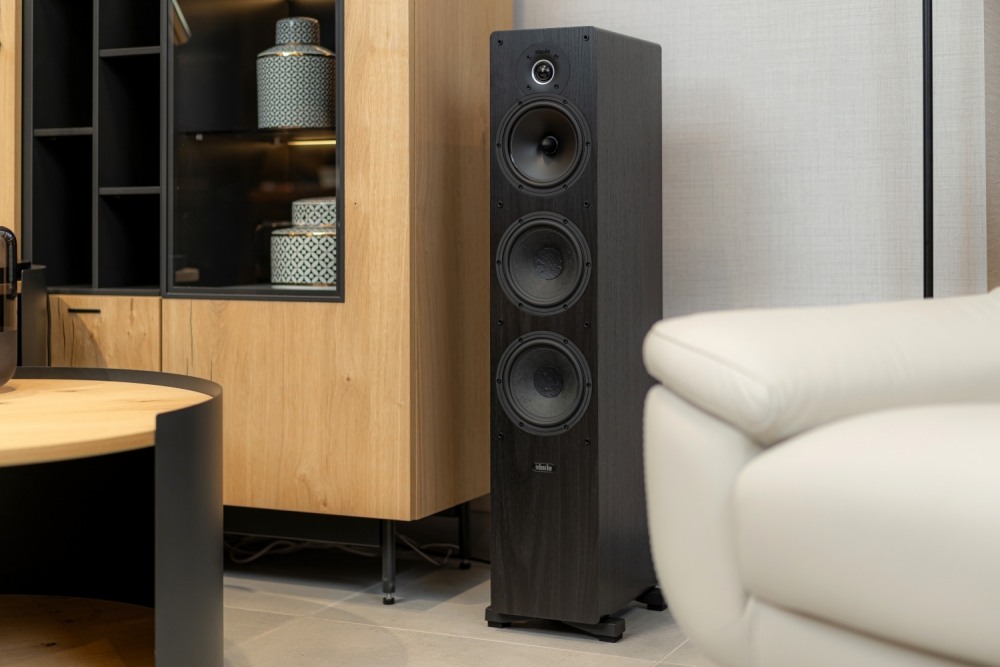
How to choose Indiana Line speakers depends of the room size?
How to choose loudspeakers depending on the size of the room? Unfortunately, this is not an obvious matter. The selection of loudspeakers for a specific listening room, e.g. a home living room, is an extremely important factor in terms of the final sound of an audio system. The choice of loudspeakers – floorstanding or bookshelf speakers – will depend on, among others, the capacity of the room in which they are to work, as well as the volume level at which we want to play music. So the efficiency of the speakers will be also important.
The financial issue is also important, i.e. the amount that we can spend on a stereo system or home theater. While in a stereo set, intended mainly for listening to music, the selection of a pair of loudspeakers will be much easier, in the case of a home theater, where we additionally use a central speaker and effect speakers (including ceiling speakers), it is not easy to choose loudspeakers, which will be appropriately adapted to the size of the listening room. For example, in a home theater system that supports Dolby Atmos surround sound, we can install even up to four ceiling speakers. In smaller rooms, configurations with two ceiling speakers will be sufficient.
All passive loudspeakers, regardless of their electrical parameters, need an appropriate power amplifier to operate.
Traditional floorstanding loudspeakers are usually characterized by a wide frequency response, strong bass and high dynamics. Because of their dimensions and the place they need in the listening room, they are also one of the key elements of the interior design, so they should be its decoration, matching the other elements of the interior, also in terms of colors.
On the other hand, bookshelf speakers are willingly chosen for stereo and home theater systems, not only because of the character of the sound, but also because of their easier placement. Due to the smaller dimensions of their cabinets, they are distinguished by great stiffness, which translates into lower distortion and lweaker resonances.
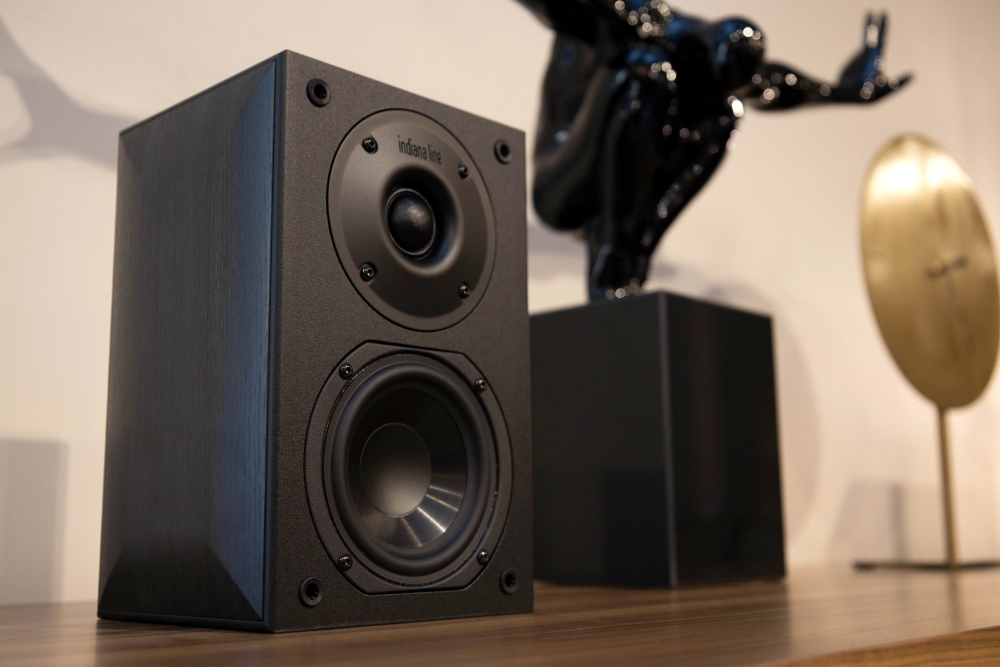
Loudspeakers and the size of the room
Regardless of whether we are dealing with high-class floorstanding or bookshelf speakers, it is difficult to say at first glance what size of the room will be the best for a given model. Together with the capacity/dimensions of the room, the power requirement and also the acoustics of the room change. The distance between the installed speakers and the listener will also be different, which is important not only for stereo sound reproduction, but also for surround sound (e.g. through ceiling speakers). The greater the distance, the more important role the sound reflections from individual walls and ceilings play.
It is difficult to define in an easy way the dimensions of the room for which the loudspeaker constructors design their models. This is due to the fact that there is no direct translation of parameters such as the size of the drivers and their membranes used, efficiency, loudspeaker power or loudspeaker impedance to which size of the listening room a given model will be the best for.
However, it can be assumed with high probability that in most large home living rooms, floorstanding loudspeakers will be the best solution, in the set with which the appropriate power of the receiver, amplifier or power amplifier should not be missing. On the other hand, in smaller rooms, e.g. because of the lack of sufficient space to set up floorstanding loudspeakers, bookshelf loudspeakers will be better.
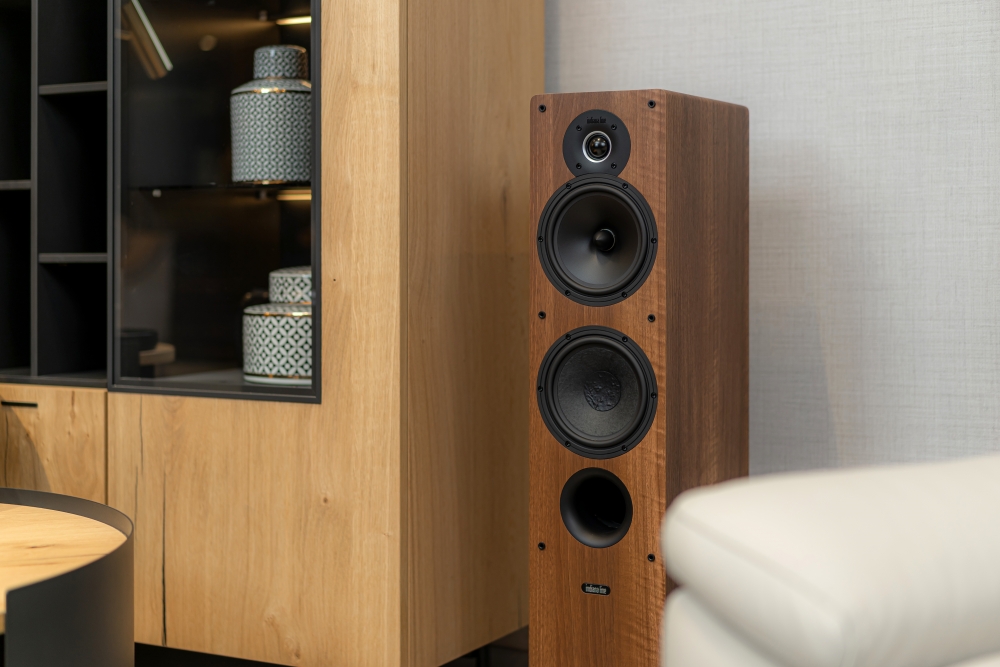
A room up to 12 m2
There are many compact loudspeakers suitable for small rooms on the market. These are both passive sets and active loudspeaker sets. So choosing speakers for a small room is not easy. We especially recommend here the Indiana Line Diva 252 or Indiana Line Tesi 241 bookshelf speakers.
Diva 252 is perfect for listening to music in a compact stereo set. It has a wide frequency response that ranges from 48 Hz to 22 kHz. The tweeter of the Diva series models has been mounted in the cabinet with an insulating rubber pad that reduces vibrations transmitted from the cabinet, improving the stereo and clarity of the treble.
The second of the mentioned models, i.e. Tesi 241, can be an excellent replacement for micro-system speakers. Like Diva 252, it has a back firing bass reflex port, so placing this speaker closer to the wall can further enhance the bass processing. The Tesi 241 loudspeakers can also be used as rear speakers (effect speakers) in a home theater system. In such a surround sound system, you can also use the Indiana Line Tesi 761 central speaker, which will be consistent in design with other models from the Tesi series.
Nota 240 X may also be an interesting proposition for a smaller interior. A small stereo system using these bookshelf speakers will not only look great in the listening room, but also provide a very good sound. Nota 240 X will work, for example, as a TV sound system, of course, in combination with an appropriate amplifier. These loudspeakers can also be used as rear/effect speakers in a home theater system. What’s more, the design of the cabinet makes it possible to hang them on the wall.
A unique design in the Indiana Line offer is Tesi Q. You can build this model in the wall or hang on it (using the wooden cabinet included in the set). Thanks to this, it will not take up much space, and at the same time will provide very good quality sound. This installation model uses the same components as the Tesi series loudspeakers, ensuring a consistent sound with them. This allows you to use Tesi Q also as an effect loudspeaker in a home theater system along with other models from the Tesi Indiana Line series, while maintaining the same tonal quality.
In smaller rooms, you can also use compact active loudspeakers (usually two-way), and even portable Bluetooth speakers (which process the full acoustic frequency range, most often using one full-range speaker). In multiroom systems, in rooms such as a bathroom or hall, the Indiana Line RD 260 or RD 280 ceiling loudspeakers can be used to create a musical background.
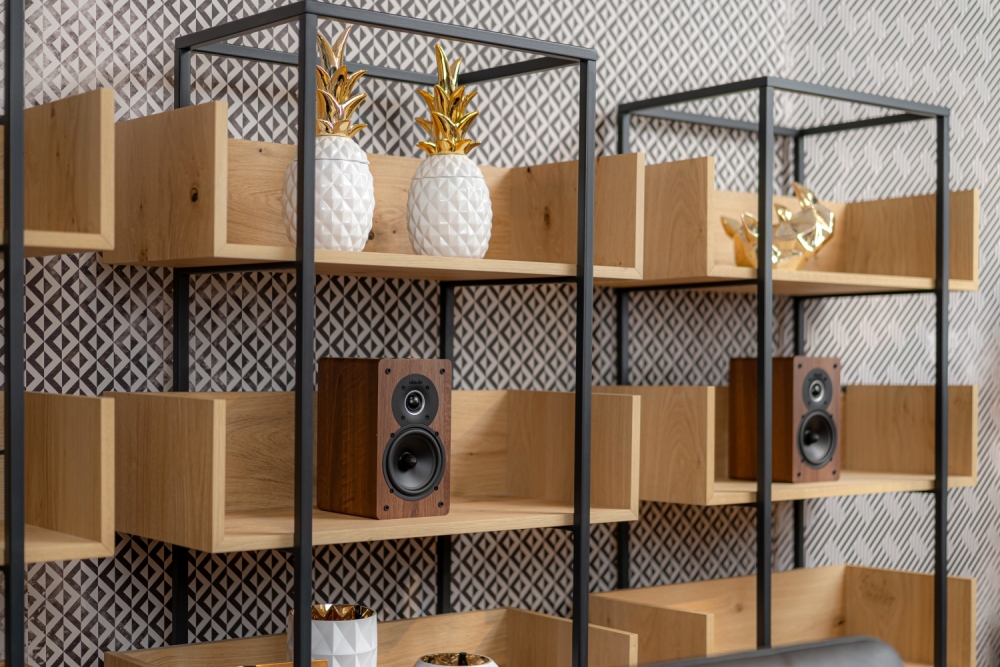
A room up to 15 m2 – which bookshelf speakers to choose?
In places where there is little space to put the loudspeakers, and the distance between the sound system and the listening position is relatively small, the compact bookshelf speakers will work well, for which there will always be a place – if not on a special base then directly on a wall unit or TV cabinet.
It is worth considering, for example, the Indiana Line Diva 262 model. These are good speakers for rooms with an area not exceeding 15 m2. This model uses a bass reflex cabinet. The port is located at the front, which allows the speaker to be positioned even very close to the wall, if necessary. This two-way design uses a Curv material woofer, which, combined with other technical solutions used here, allows for a clear and dynamic sound.
Our next proposal are the Indiana Line Tesi 261 speakers, which will fit perfectly into any interior. It is also a model with front ported bass reflex, which facilitates easy positioning. It will work wherever there is no room for large floorstanding speakers, but at the same time we do not want to give up the high-quality sound reproduced by our audio system.
From the Indiana Line offer, it is also worth paying attention to the Nota series and its Nota 250 X loudspeakers, which use timeless cabinets with elegantly contoured side panels that emphasize the elegant shapes of this model. Thanks to this, Nota 250 X will not only be a decoration of any interior, but at the same time will allow you to obtain an emotional sound with exceptional dynamics as for a bookshelf construction.
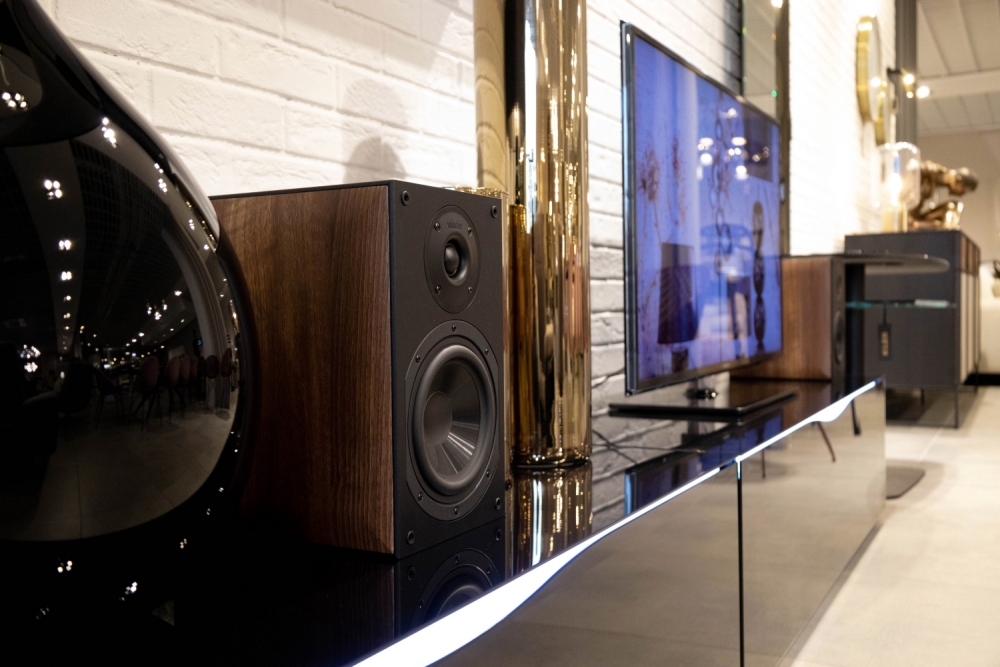
A room up to do 20 m2 – floorstanding or bookshelf speakers?
In rooms with an area of 15-20 m², depending on the preferences of the listener, both bookshelf speakers and smaller floorstanding speakers can be used.
If you have space for floorstanding loudspeakers, then we recommend creating a stereo system based on a pair of Indiana Line Diva 552. Noteworthy is a 2,5-way speaker system with properly insulated tweeter. The Diva 552 loudspeakers have paper cones (made of natural cellulose pulp) in the woofers. The Divy woofer, on the other hand, is a structure that uses the innovative Curv material, which is created by the appropriate combination of fibers distinguished by high stiffness and high internal damping. As a result, a warm, pleasant sound and great dynamics have been obtained.
Among the floorstanding models, in the case of a room up to 20 m2, the Indiana Line Tesi 561 loudspeakers also deserve attention. They are also 2,5-way speakers and, like Diva 552, have a bass reflex port at the front. This makes it easier to place them in the listening room. Instead of a black piano finish, we have an elegant vinyl in the shade of black oak or light walnut. This model can be connected in bi-amping/bi-spinning mode, which allows you to get even better sound from it.
The third floor option is the Indiana Line Nota 550 X loudspeakers. The only floorstanding model from the Nota series is also a 2,5-way design using a stylish MDF cabinet with resonance damping internal reinforcements. In the midrange, this model sounds warm and gentle, and the woofer used in it guarantees strong and deep bass. The special design of the tweeter filter is also noteworthy, as it allows for clear and distinct treble.
For people who, despite the fact that they have a room with a relatively large area, but do not have space for the appropriate arrangement of the aforementioned floorstanding models, we recommend the Nota 260 X 2-way loudspeakers with a back ported cabinet.
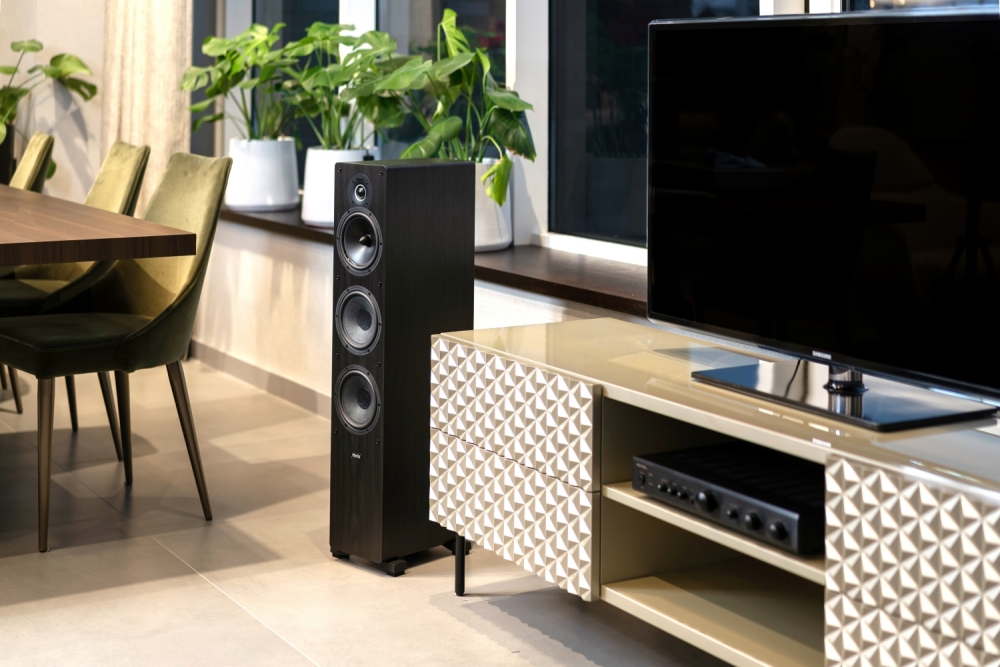
Area up to 25 m2 and floorstanding speakers
If the interior is relatively large, and additionally well damped, then it is necessary to use a model with high efficiency and using transducers with a large-area membranes. Most floorstanding loudspeakers will work well in this type of room, as the electroacoustic transducers responsible for low and medium tones are usually larger in size.
In this segment, we recommend the Indiana Line Diva 660 loudspeakers, the top model from the current offer of this Italian audio brand. They have a 3-way design and will provide high sound quality even in a large living room. Unlike many similar models using three drivers (one for each of the processed acoustic ranges), Diva 660 has 4 built-in speakers – tweeter, mid-woofer and two woofers. This ensures a wide range of processed sounds, and at the same time a natural sound with a wide and emotional soundstage.
An alternative to the above model can be the Indiana Line Tesi 661 loudspeakers. They are also 3-way and, like Diva 660, they can work in bi-amping/bi-spinning. Due to the back firing port and a relatively large structure with a massive cabinet, Tesi 661 will show its full potential at a distance of about a meter from the wall of the listening room.
A room over 25 m2 (up to 30 m2, up to 40 m2, up to 50 m2)
In larger living rooms with an area of 30 m2, 40 m2, and even 50 m2, so much above the aforementioned limit of 25 m2 – bigger floorstanding sets or large monitors with sizable diameter woofers can be used. The models of this type should be characterized not only by a wide frequency response, but above all by high efficiency.
We recommend using the Indiana Line DJ 308 or DJ 310 loudspeakers to amplify large spaces. These are 3-way models with a double bass reflex tunnel and built-in large woofers. The DJ 308 has a bass driver with a diameter of 230 mm, while the DJ 310 model has a diameter of 275 mm. In combination with other electroacoustic transducers, it allows for a strong and full sound. These models will successfully provide sound even for a large training room. The design of the DJ series loudspeakers is also noteworthy. It is kept in a classic, vintage style.
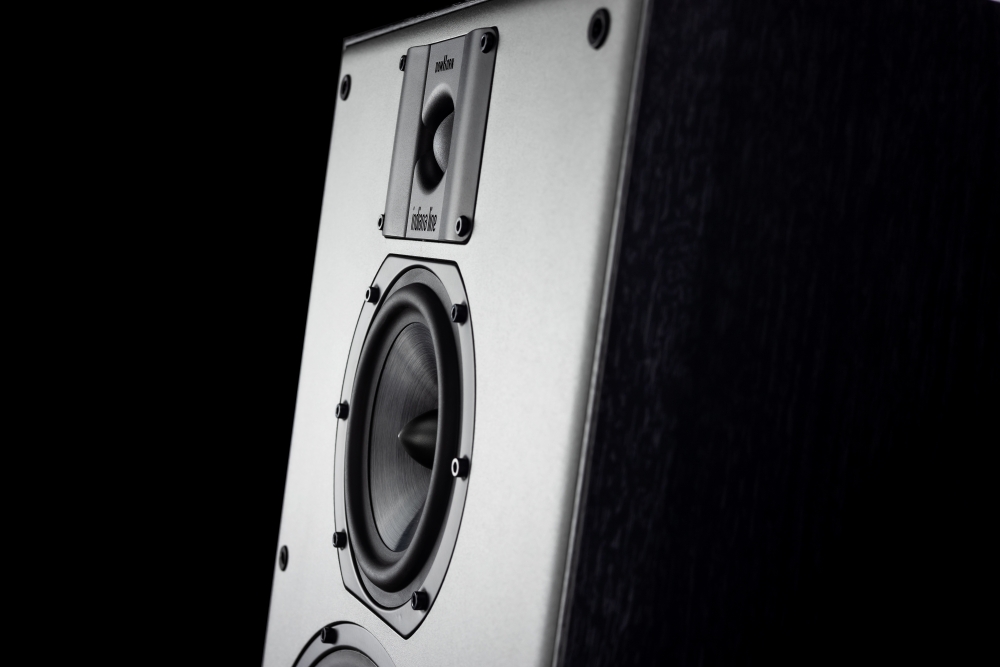
Subwoofer as an additional woofer
In large rooms, especially in home theater systems (for watching movies), an additional external woofer may be a necessary complement to the other loudspeakers. Usually it is an active subwoofer, so the one that has a built-in amplifier. Its use will significantly improve the sound quality in the low frequency range.
Rooms with a large capacity require appropriately “powerful” subwoofers so that they are able to generate the appropriate sound pressure necessary to obtain strong bass. In smaller interiors, the models with relatively low power may be sufficient, especially as for an active subwoofer.
It is worth experimenting a bit with the placement of the subwoofer in the listening room and choose the optimal position that will provide the appropriate level of bass reproduction. Of course, we experiment as much as the interior arrangement allows us. Placing the subwoofer in the corner of the room can emphasize the bass. It is also worth paying attention to the phenomenon of “dead spots”, i.e. the occurrence of places where the bass is clearly weakened.
If we are not able to properly adjust the position of the subwoofer, it is worth using the automatic calibration system, with which, for example, an amplifier or home theater receiver can be equipped. However, if we do not have an audio component that supports this type of solution, then it is worth choosing a subwoofer that will allow us to manually, precisely calibrate its settings and tune the sound to the other loudspeakers (floorstanding or bookshelf speakers, depending on the selected models).
If you want to amplify a large room of over 30 m2, you can use more than one subwoofer with its own amplifier, which will provide strong bass, but also allow for a more even distribution of the sound of the reproduced sound. Then it is worth that all subwoofers should be identical. However, it should be remembered that increasing the number of woofers in a loudspeaker system does not always have a positive effect on sound quality.
Among active subwoofers, it is worth taking a closer look at two models offered by the Indiana Line brand. We mean Basso 840 and Basso 880. Both are equipped with a rich control section, thanks to which we can properly adjust parameters such as phase, cut-off frequency or amplification of the audio signal (taking into account the other speakers), obtaining a strong, deep bass. The models differ mainly in the class of operation of the built-in amplifier, and thus also in power. Indiana Line Basso 880 is a class D construction with power reaching 400 W, while Basso 840 works in AB class and is characterized by maximum power of 125 W. Moreover, Basso 840 has a bass reflex cabinet, and Basso 880 is a sealed cabinet design. The subwoofer cabinet, as in the case of other loudspeakers, will affect the way it is placed in the listening room. When choosing the right model, it is worth taking into account not only its power, but also the above-mentioned cabinet construction.
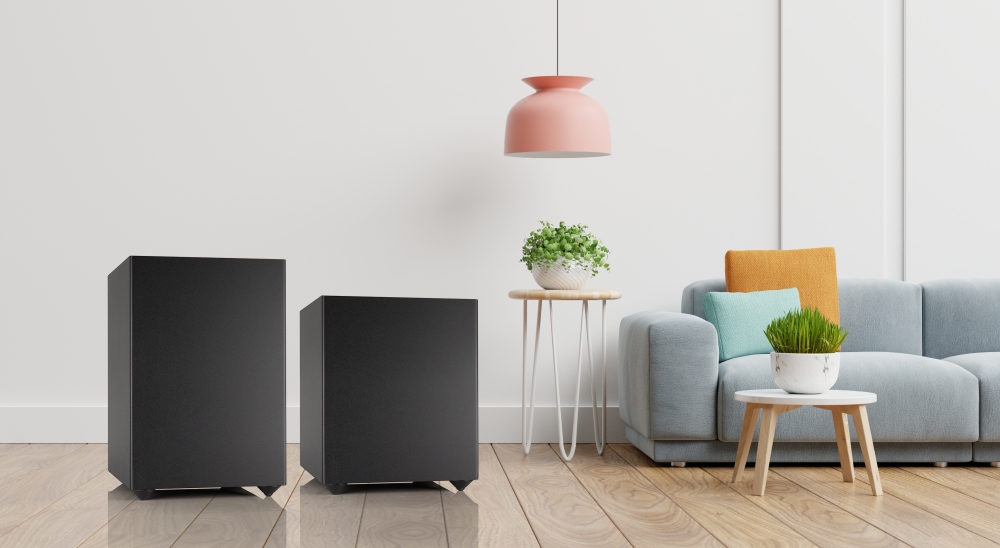
Capacity, shape and acoustics of the room
When talking about the choice of loudspeakers for a specific room, all considerations are usually limited only to its capacity. Meanwhile, the third dimension, i.e. the height at which the ceiling is located, also plays a significant role. It has a remarkable impact on the character of the sound, both in terms of the level of distortion and the level of power necessary for an amplifier to provide sound to such an interior and various electroacoustic transducers used in the loudspeakers.
Not only the capacity of the room, but also the proportions of its individual dimensions (including height) will be important for the sound of the loudspeakers placed in it. In the professional literature, you can even find special guidelines to the mentioned proportions. One such “golden ratio” is 1,85:1,5:1 (respectively: length, width and height). Assuming that the average height of the room is approx. 2,7 m, the optimal size will be a room with individual walls of 5 and 4 meters (20 m2).
You can also meet the guidelines taking into account the dimensions of the room, according to which the ratio of width, length and height should be 1:1,25:3,2 for small rooms (up to 12 m2), 1:1,6: 2,5 for medium-sized rooms (up to 20 m2) or 1:1,25:3,2 for large listening spaces (25 m2 and more).
However, these are only some guidelines, because practice shows that there is no one clear recipe for an acoustically perfect interior. Above all, however, none of the dimensions of the room should be the same, and they should not be multiples of each other.
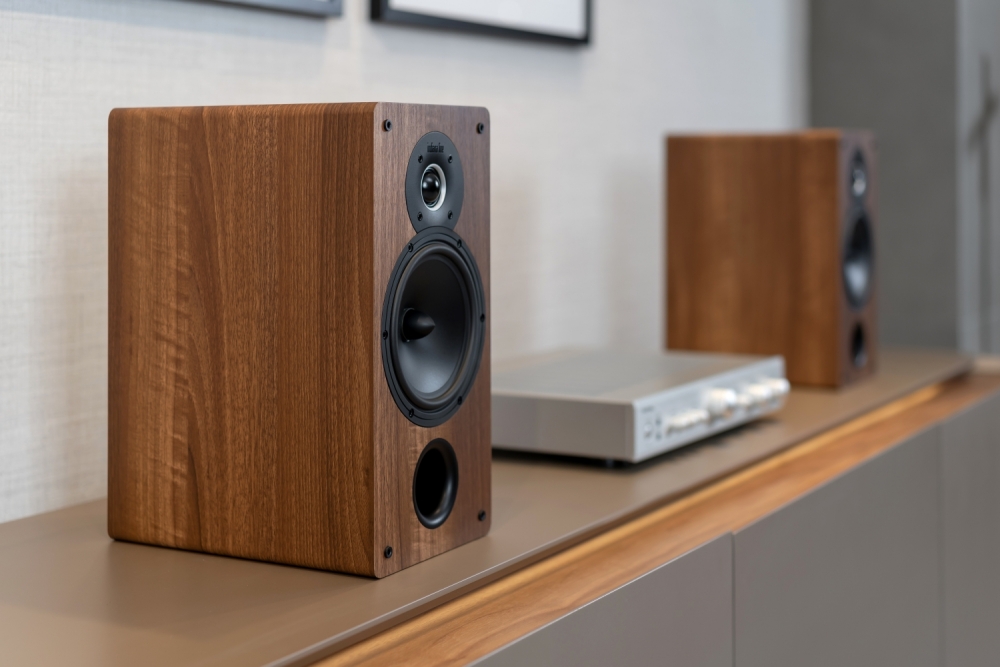
Before we install a stereo system (e.g. for listening to music) or a home theater system (designed mainly for watching movies), and we have a choice of two different rooms for possible use, it is worth checking which one will be better in terms of proportions and acoustics for our loudspeaker sets .
Even a very expensive audio system, equipped with the most advanced loudspeakers providing a wide frequency response, but placed in a room not adapted to it, will simply sound average. That is why it is worth paying attention to what is in our listening room. Soft, fabric elements of the interior design, such as carpets, curtains or upholstered furniture, absorb sound. Their proper location is of key importance here. In many cases, the acoustic properties of the room can be regulated quite significantly, e.g. by changing the position of furniture or damping and absorbing fabrics.
In practice, it is usually not easy to modify the dimensions of individual walls, and it is not easy to make some compromises and concessions with the interior design. It then remains to correct the acoustics of the room with the help of appropriate acoustic systems that absorb or diffuse sounds reproduced by audio and loudspeakers in a stereo or home theater system.
